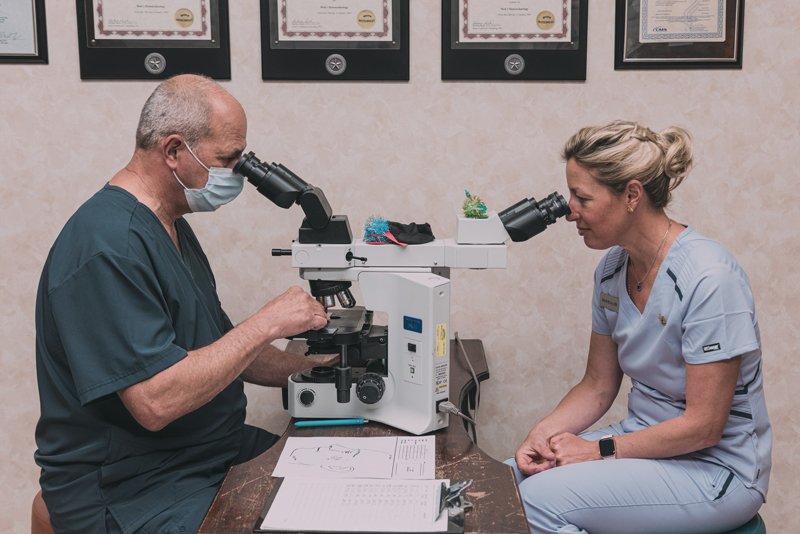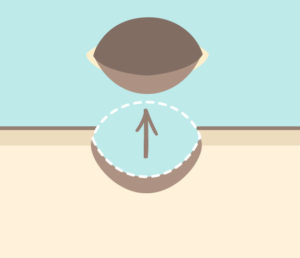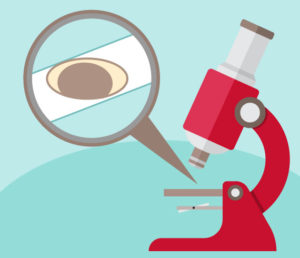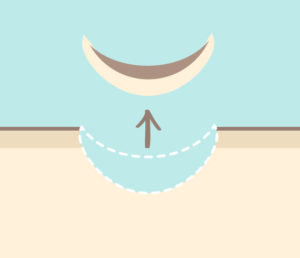Certain types of skin cancers are highly aggressive, difficult to treat and cannot be removed by freezing or a simple excision. For these situations we move forward with a more comprehensive, specialized care called Mohs Micrographic Surgery. This is a highly effective technique developed by Dr. Frederich Mohs that allows for the removal of all cancer in an affected area with minimal damage to surrounding healthy skin. This procedure offers patients the highest cure rates — complete cancer removal in 99% of cases for those who have not previously been treated for skin cancer. The first to bring this innovative procedure to the Paducah area, Dr. Jeffrey Case, M.D. has been performing Mohs surgery since 2002.

How It Works:

During this outpatient procedure, the affected tissue and its “roots” are removed surgically after the patient is given a local anesthesia.

While the patient waits, the pathology is then examined in one of our two in-house labs to determine if cancerous cells remain present in the edges of the removed tissue.

If cancerous cells remain, the removal process is repeated until they can no longer be detected under a microscope.

Once the procedure is complete, surgical repair is performed and the patient is given instructions to care for the wound as it heals.
Typically, the procedure takes around three hours; however, it is not uncommon for it to last longer if the microscopic removal process is repeated. To inquire about Mohs Micrographic Surgery or to schedule a consultation with Dr. Case, please call (270) 443-2471 to make an appointment.

Certain types of skin cancers are highly aggressive, difficult to treat and cannot be removed by freezing or a simple excision. For these situations we move forward with a more comprehensive, specialized care called Mohs Micrographic Surgery. This is a highly effective technique developed by Dr. Frederich Mohs that allows for the removal of all cancer in an affected area with minimal damage to surrounding healthy skin. This procedure offers patients the highest cure rates — complete cancer removal in 99% of cases for those who have not previously been treated for skin cancer. The first to bring this innovative procedure to the Paducah area, Dr. Jeffrey Case, M.D. has been performing Mohs surgery since 2002.

During this outpatient procedure, the affected tissue and its “roots” are removed surgically after the patient is given a local anesthesia.

While the patient waits, the pathology is then examined in one of our two in-house labs to determine if cancerous cells remain present in the edges of the removed tissue.

If cancerous cells remain, the removal process is repeated until they can no longer be detected under a microscope.

Once the procedure is complete, surgical repair is performed and the patient is given instructions to care for the wound as it heals.
Typically, the procedure takes around three hours; however, it is not uncommon for it to last longer if the microscopic removal process is repeated. To inquire about Mohs Micrographic Surgery or to schedule a consultation with Dr. Case, please call (270) 443-2471 to make an appointment.
Mohs: Commonly Asked Questions
My biopsy site has healed and I cannot see any more cancer. Do I still need Mohs micrographic surgery?
Patients often are unable to see or feel any remaining cancer after the biopsy heals. However, many cancers will have “roots” that need to be removed with Mohs micrographic surgery.
Will I be put to sleep?
Mohs micrographic surgery is an office procedure that is done under local anesthesia and you will not be put to sleep.
Should I eat or take my medications the day of surgery?
It is very important to eat a good breakfast and take all your medications on the day of your surgery. Most medications including blood thinners can safely be taken unless you have been specifically asked to stop them for a short period of time.
How long will the procedure take?
Although it is possible that we may be able to remove your tumor, examine the specimen and reconstruct the defect in as little as three hours, it is not uncommon for the entire process to take more time. We ask that you reserve the entire day for the procedure. You should not make any other appointments or schedule any other types of activities for the entire day.
Is Mohs covered by my insurance?
Yes; most insurance companies, including Medicare, cover the procedure. Click here to learn if your insurance is accepted by our clinic.
If you have any other questions about your Mohs micrographic procedure, please do not hesitate to call the office prior to your surgery.
“I treat probably 3 or 4 fast growing skin cancers every day. If you have a concern, please call us.”
– Dr. Jeffrey Case, M.D.
